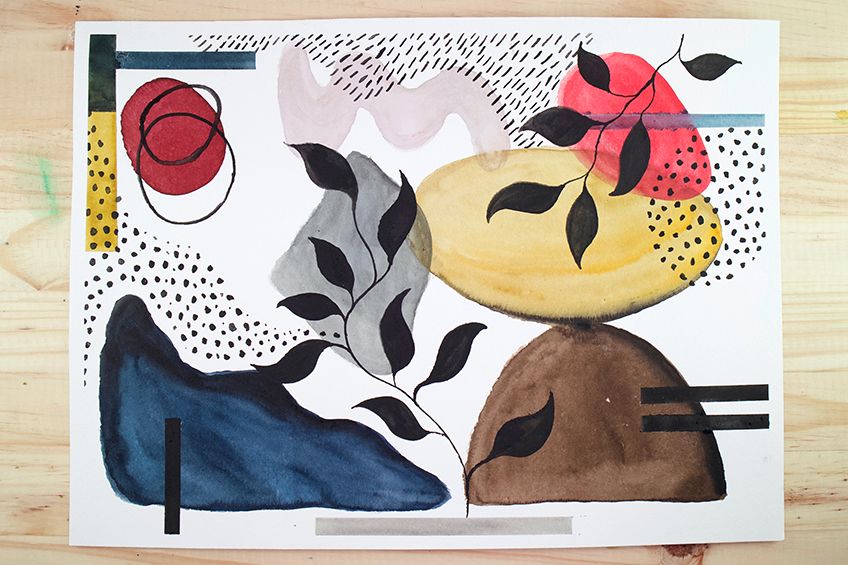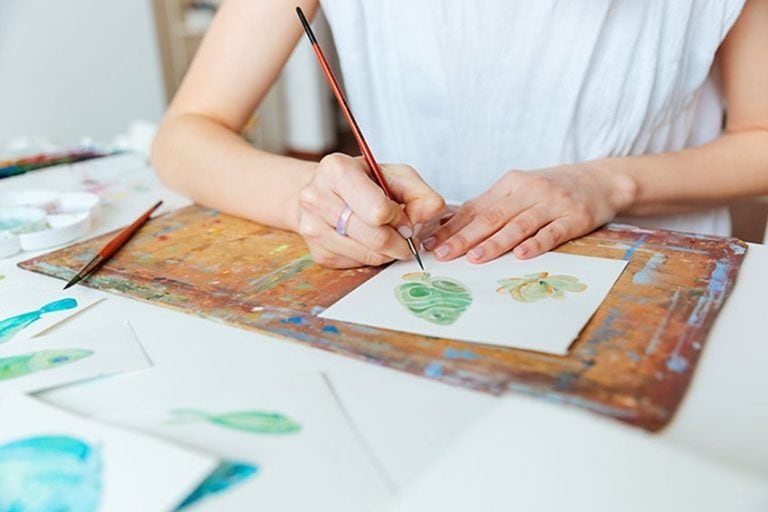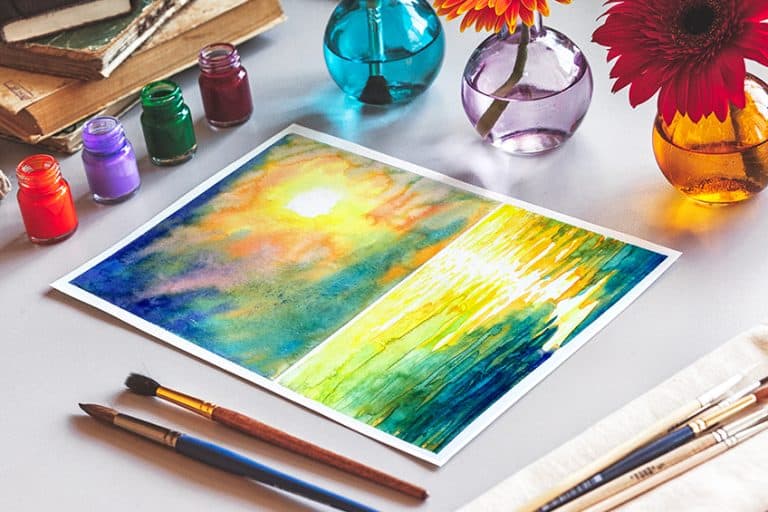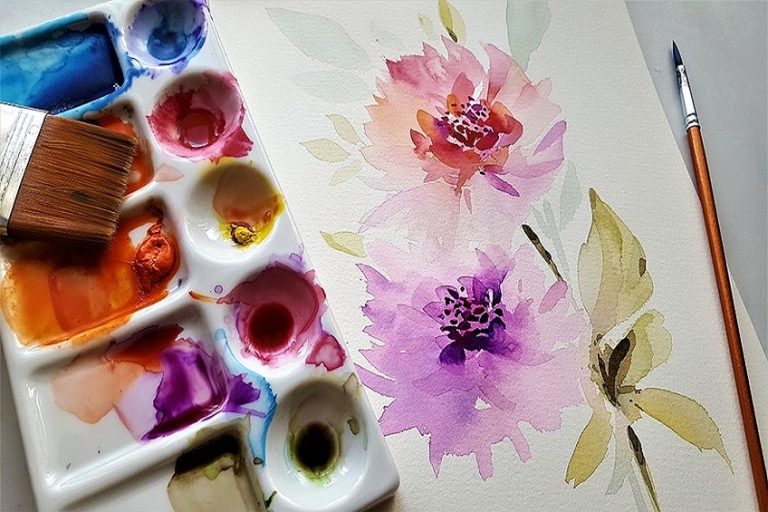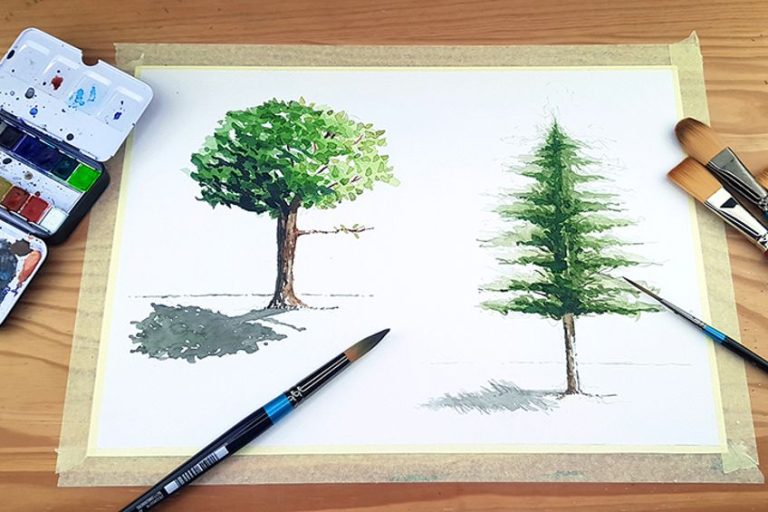Abstract Watercolor – Easy Watercolor Abstract Painting Techniques
When doing an abstract watercolor painting there are so many ways in which someone could approach this type of watercolor art. Watercolor art is so diverse and there is a lot that can be done with the medium to achieve various desired outcomes through various watercolor techniques. There are many different watercolor techniques that in and of themselves can be classified as an abstract form of work. Knowing how to abstract paint, therefore, is not done so through a specific formula, however, in this tutorial on how to paint an abstract watercolor, we will go through a few abstract painting techniques that you can either follow directly or apply differently to your painting.
Table of Contents
Preparation
When painting with watercolor, we want to make sure we have an environment that is conducive to focusing. This means, place yourself somewhere where it is quiet and you can relax as you go through this tutorial. We want to make sure we have two cups of water for rinsing our brushes. Lastly, we want to make sure we tape our paper down to our table to keep it secure.
As we learn how to paint abstract watercolor, we will find that it requires moments of waiting for paint to dry, so perhaps listen to some music or a podcast while doing this tutorial.
An Easy Watercolor Tutorial for Beginners
Abstract watercolor painting is such a fun exercise because there is no wrong way or right way. In this tutorial, we will be painting an abstract natural landscape. Abstract watercolor is where we play around with various shapes, colors, and techniques. Many watercolor tutorials are often describing specific watercolor techniques to help you apply them to more realistic scenarios within a painting.

With abstract watercolor painting, we want to completely abandon that idea and as we go through various abstract painting techniques, we will find that abstract watercolor painting is really about your own desired combination of colors and shapes. However, in this tutorial, we will paint something using some natural tones and shapes. There are a few helpful tips in this tutorial that you can take with you to other abstract watercolor paintings in the future. With that said let us get started.
Step 1: Painting Shapes for the Background
Let us begin by painting some general shapes. WIth abstract paintings, a great way to start is to put down some shapes that will form the background of a painting. However, we want to be conscious of the color combinations we want to use.
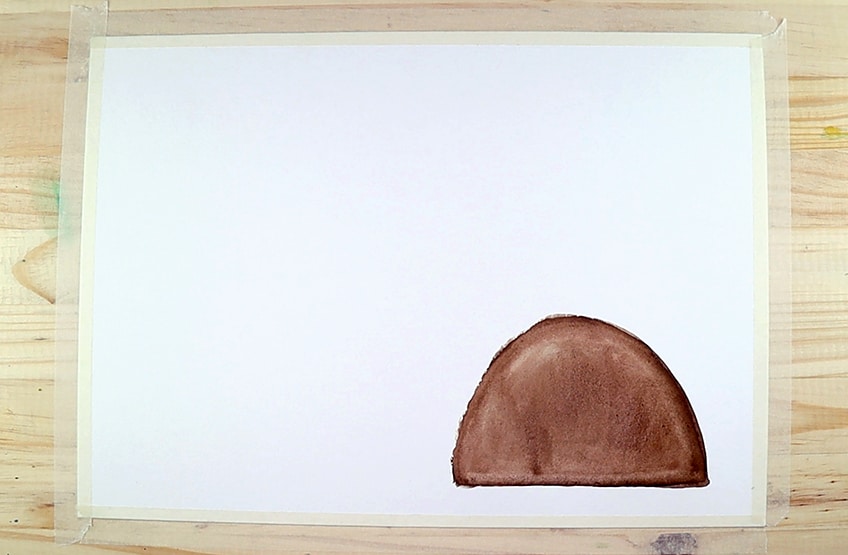
Creating shapes is always a great way to start an abstract artwork. However, a good idea is to know what kind of color palette you’re interested in and then work from there. Perhaps some natural tines work well.
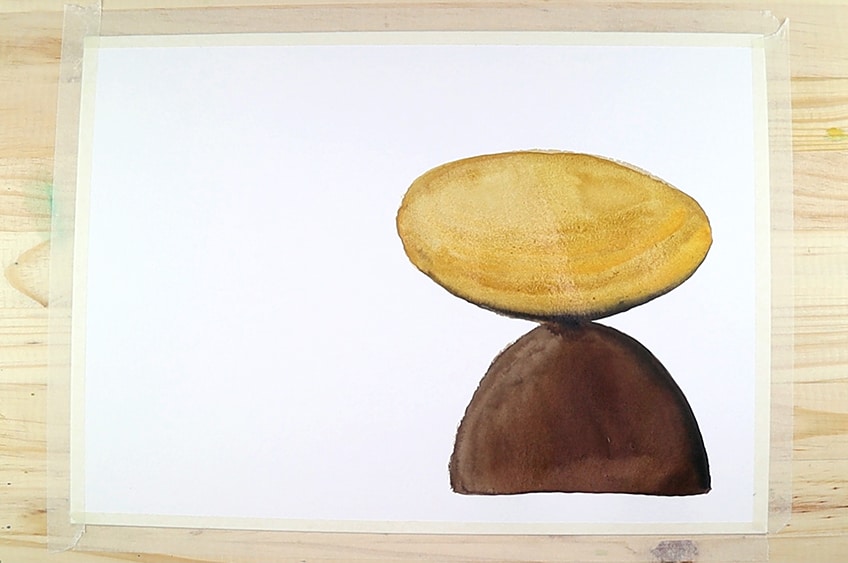
What we can also do to make some interesting marks in our abstract art is join shapes in their edges whilst the paint is still wet. What this will do is create a nice merging effect as the paints merge because they are both still wet. As you connect the shapes perhaps put a touch of black near the connection point.
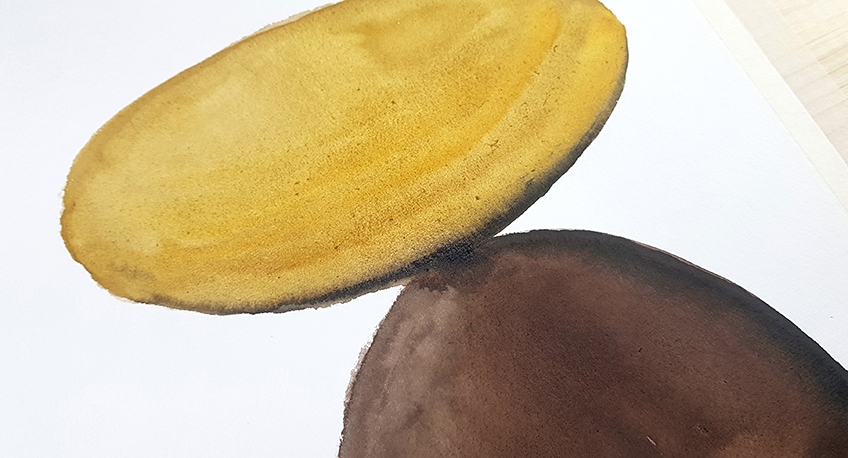
You can either create various color combinations in your shapes whilst the paint is wet, however, sometimes it also looks nice and simple when the shape is a single color. A great way to make a new mark is to think about the current shapes you have and perhaps strategically think about how you can include a new shape in the painting in a way that starts to broaden the artwork. A good suggestion is to also explore color combinations that work well with your current colors.

Creating balance in the artwork so that the composition of the painting seems aesthetically nice can be quite tricky. This has a lot to do with both color combinations as well as the type of shapes one might want to use. Since we are exploring natural color palettes, let us consider using a deep blue.

If you feel that there are too many of the same shape or it feels too singular, break that by painting a new kind of shape. As we paint shapes to create an interesting background, we want to also consider the total value of our shapes, some might be light and some might be darker. It’s nice to break the constant color tone by adding in some lighter color tones sometimes. A great way to do this is by creating washes of colors that are highly diluted by water. This means that some are more vibrant and some a little more transparent. You can also allow for some of your shapes to overlap with your dry shapes. This is a great technique that you can explore in further detail if you like by overlapping many shapes. However, sometimes it is also good to keep it simple.
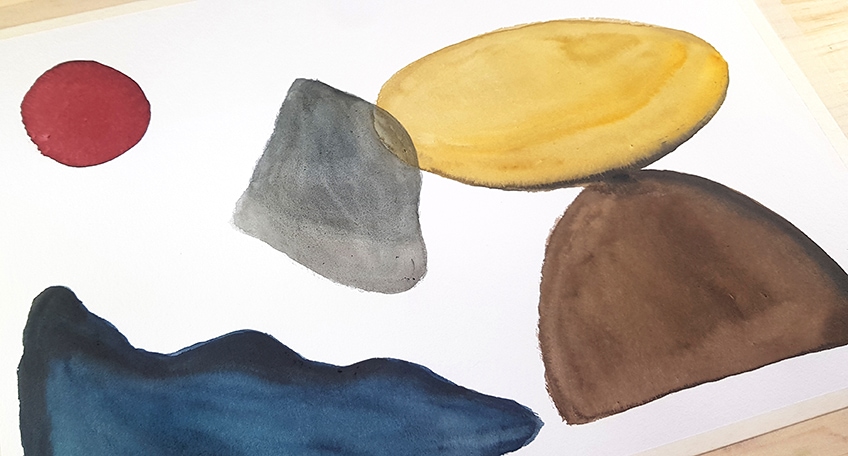
You can continue to explore this overlapping technique with other colors and other shapes. This technique works well with watercolor, so when it is done well it can look really beautiful in an artwork.
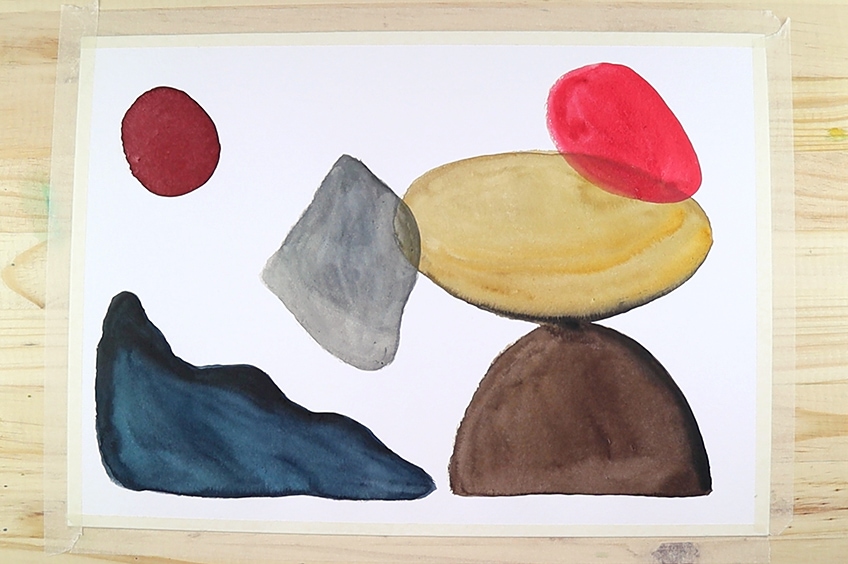
Keep playing around with shape, color, and opacity variations until you feel that you are satisfied with the result and how your painting balances. Again, consider color combinations and shape combinations, you also want to consider if you want a lot or a little.
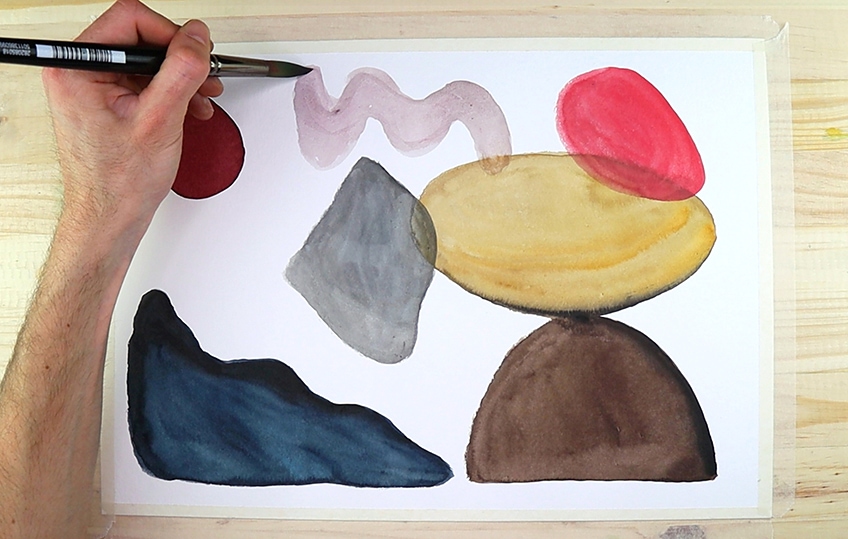
Step 2: Painting with Masking Tape
Masking tape or scotch tape is such a great tool to be used for achieving different types of effects in an abstract watercolor painting. It helps to create nice sharp edges and more geometric type marks in an image. However, like all mark-making, try to be strategic with how you would like to place the tape.

It can also be helpful to use around a painting so that there are interesting marks within the painting but don’t necessarily overwhelmingly disturb the painting.
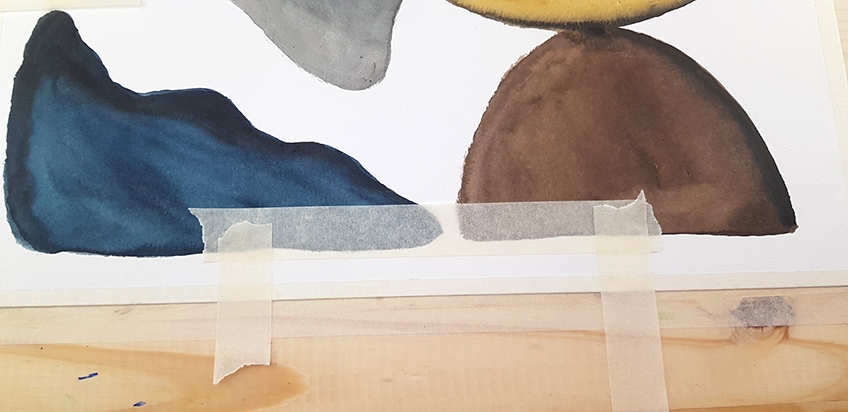
It’s also good to distribute where exactly you might put your masking tape. By this, I mean that sometimes it works well to create clusters of lines but in other cases, it can be nice to have similar marks spread out around a page.
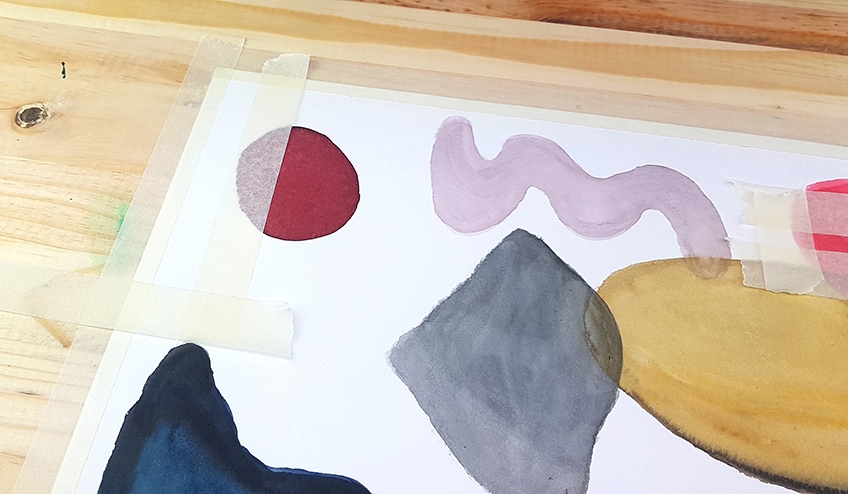
Once you have made some demarcated areas on your painting with your masking tape, again, it is helpful to consider the color combinations you might want to use in a painting. Consider the overlapping quality that color might have over another.
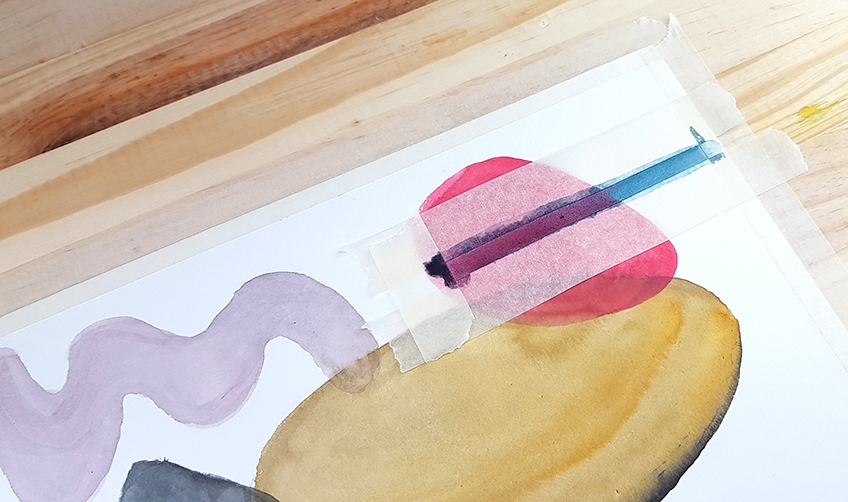
However, sometimes it is not about the overlapping quality of color combinations but the comparative aspect of two colors and how they might complement each other. For instance, warm yellows work well with rustic red colors. Try to consider color pairings.

Masking tape is quite specifically linear and allows for beautiful geometric moments in a painting, however, if that is not always the desired outcome it might be helpful to be quite sparing with the use of masking tape. If you use it, again, always consider the color combination.
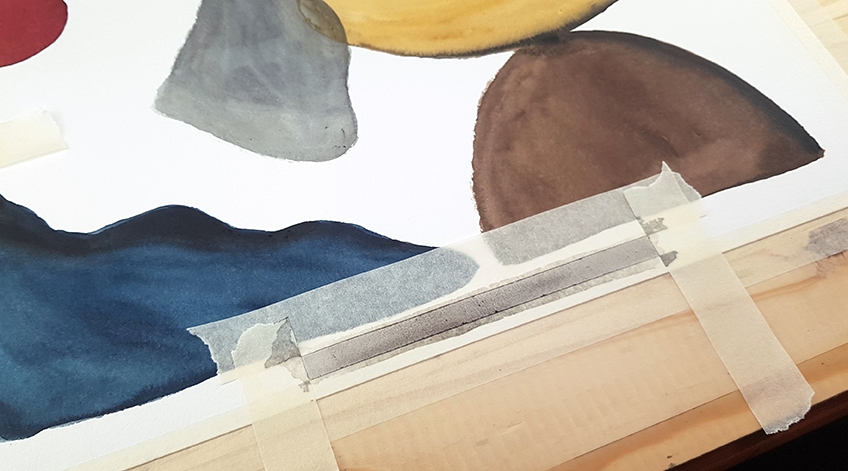
Step 3: Adding Natural Elements
Once the painting has dried and you feel that you are satisfied with the result, you can begin to add some interesting details on top of the background. A good suggestion is to consider other natural elements like flowers, plants, and leaves.
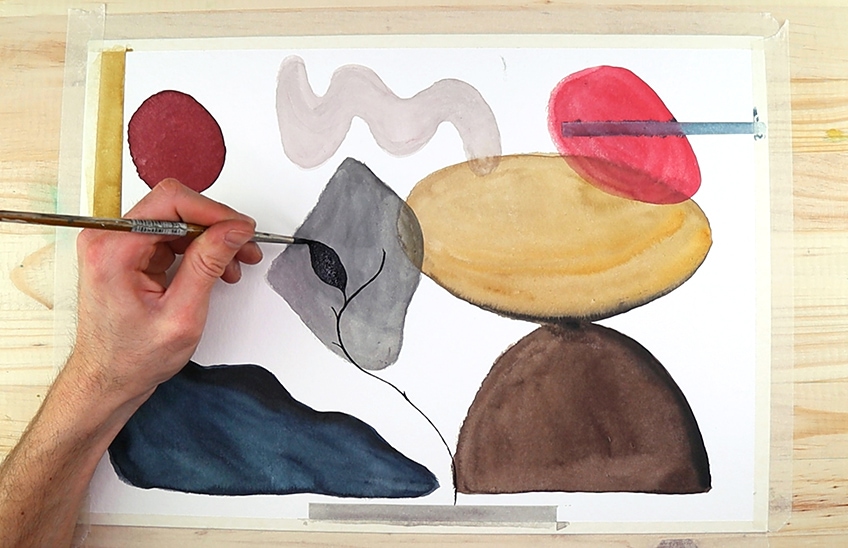
Natural elements such as plant shapes can often look beautiful when paired with natural color palettes and simple shapes. This can give an earthy or stone-like quality to some of your shapes as the plant shapes interact with them.
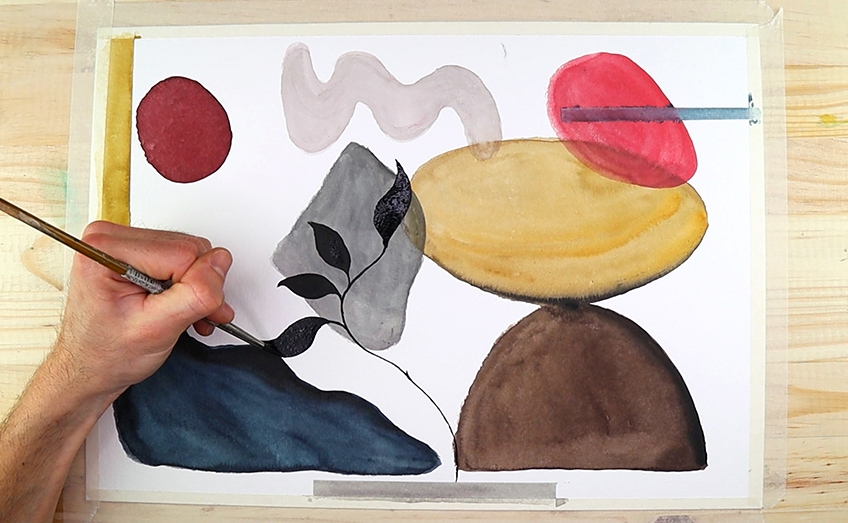
If you incorporate a plant-like quality into your drawings consider different types of shapes that different types of plants have. Some have elongated strands and others resemble the common leaf shape. Consider how these shapes work with your current shapes.
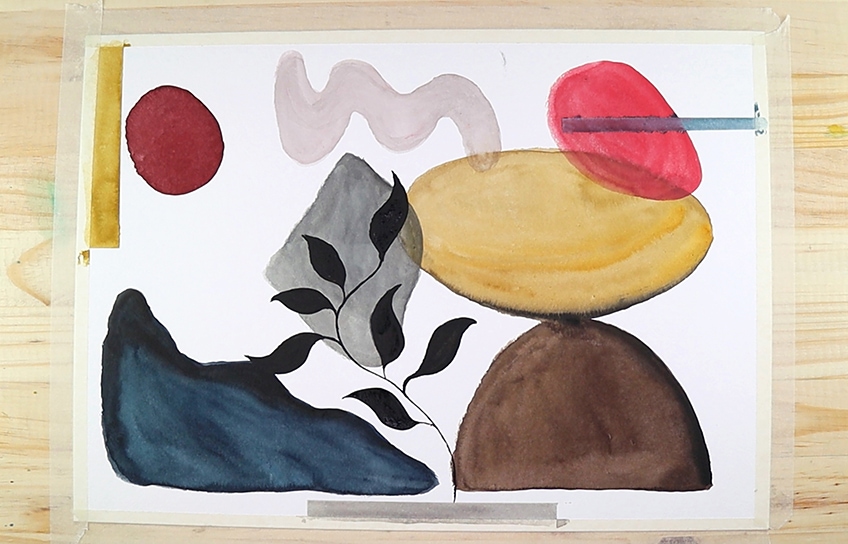
Another good suggestion is to consider how many components you would like to form part of these technical details. Sometimes we do not want to overwhelm our drawing with too much. You can also choose to make these marks lighter, however, another good suggestion is to make a silhouette over your current shapes for contrast.
Step 4: Exploring Various Marks and Strokes
Adding various lines and dots can also be a great feature in abstract artwork. Doing this has the potential to break any repetitive moments in abstract work and can also give a texture-like quality to a painting.

Again, like all applications of various marks, you always want to consider how much is too much or too little. This is completely open to interpretation; however, the balanced aspect of an abstract work can refine it and turn it into a more fine art piece of watercolor art.
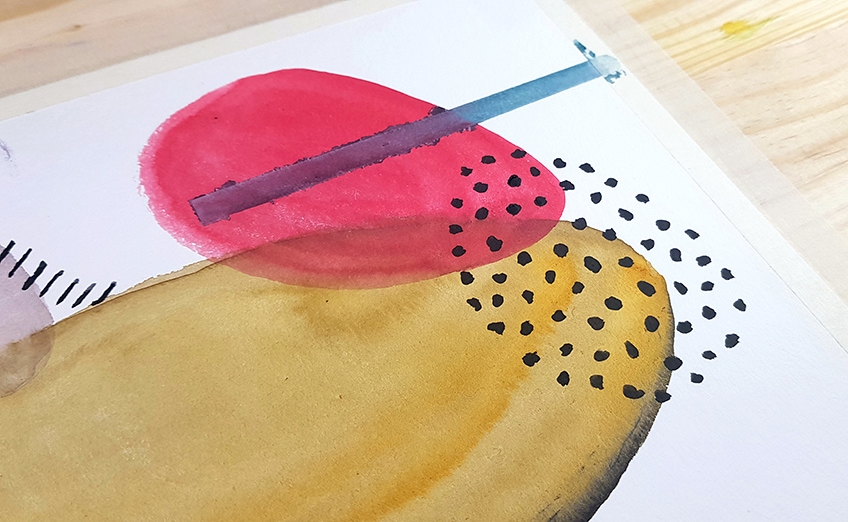
Playing around with different kinds of line marks can nuance your artwork and make it more interesting. We can explore this in a variety of ways, whether it be a series of little lines or simply creating linework over already existing shapes.
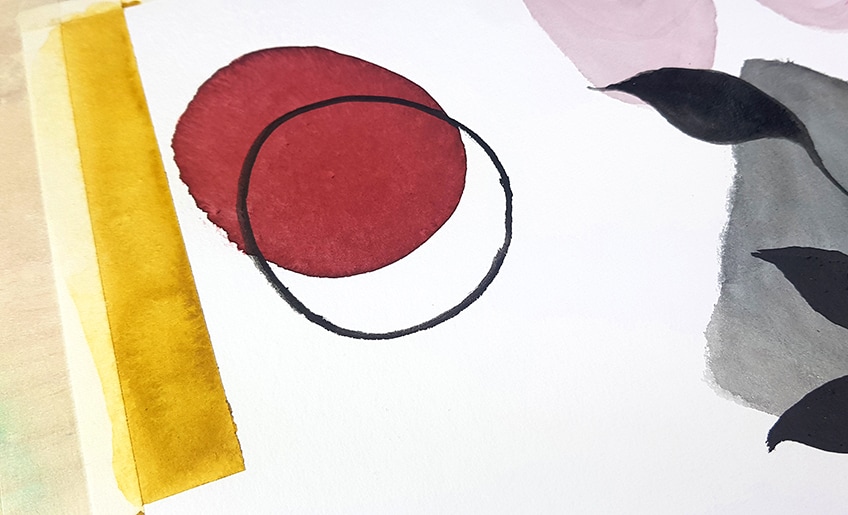
Lines can be used for various effects in an abstract painting. Exploring various mark-making styles is also really fun. However, remember to be quite sparing as you add each mark as painting is an additive process that we cannot undo once we have made a mark.
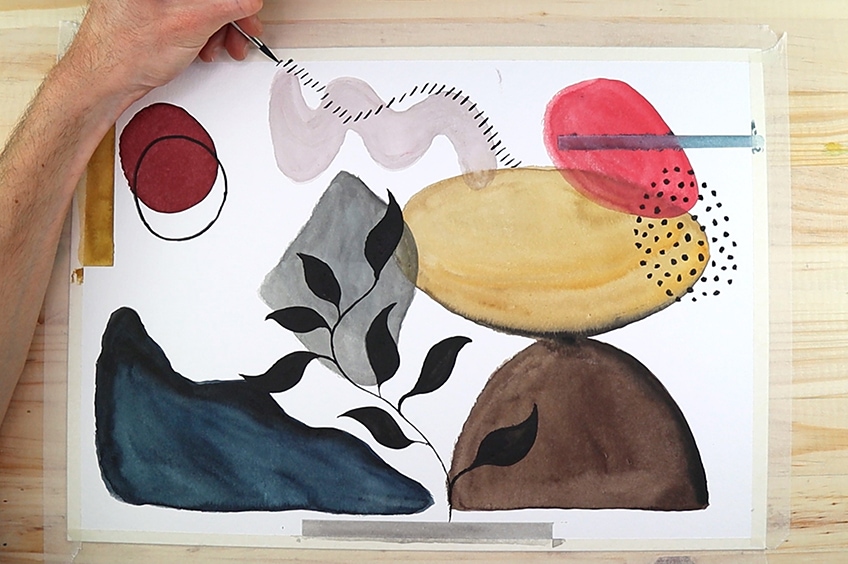
Try to understand how you feel about the composition and the balance of various shapes. By doing this we will find that perhaps there is too little of one mark and we might want to add a little more. This is the general process of painting abstract, feeling if the image needs a little more of something or if it needs a little less.
Step 5: Stepping Back and Considering the Painting
Breaking an abstract painting into a tutorial is not the most didactic thing whereby there is an explanation that directly describes what you should paint. Rather it is a guide that navigates the painter through a mental process of decision making. In this case, we want to step back and see where we might want to add a few more details if the painting needs that. If not, that is ok too and you should stop once you are satisfied with your abstract painting.
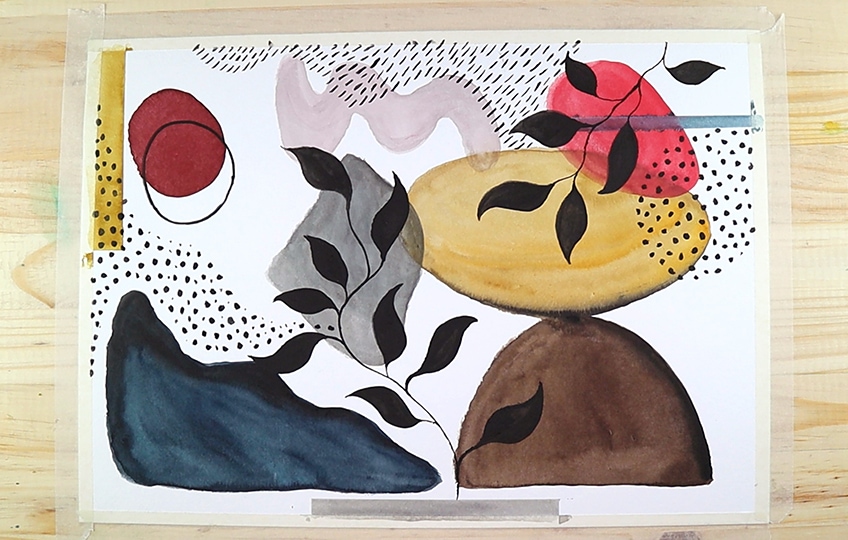
Lastly, we want to take a moment to reflect on our work. By doing so it allows us to gain a fresh perspective on the work that allows us to make more informed decisions regarding whether it might need anything else. Again, it is about balancing the work. Perhaps coming back to the juxtaposition between organic and geometric shapes might be a nice feature to reconsider. This combination of two different types of marks can make for very interesting-looking watercolor artwork.
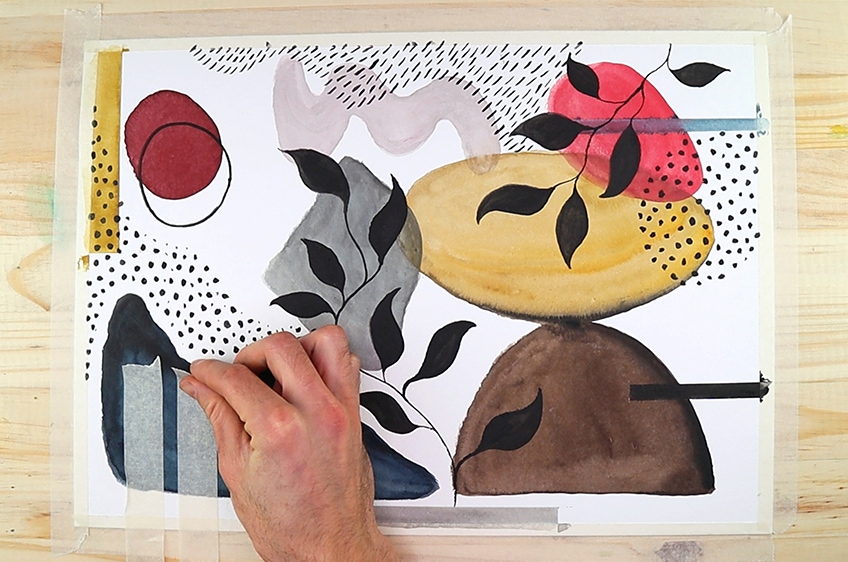
As you continue your abstract watercolor painting, consider the various abstract painting techniques and allow yourself to make decisions based on your desired outcome. Sometimes a busty abstract painting can make for a beautiful piece of watercolor art. Consider what you have learned in this tutorial and experiment.
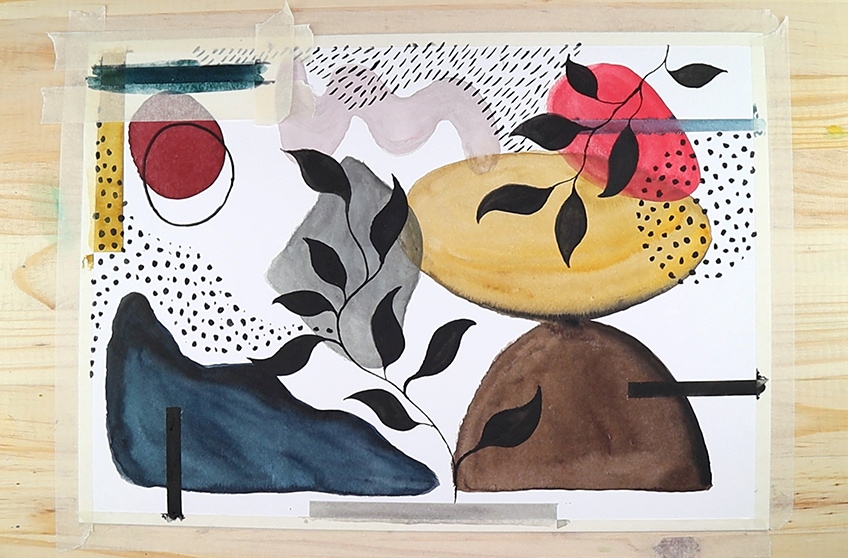
Lastly, it is very important to make sure you do take a step back every once in a while to consider whether your painting is complete or not. Watercolor art can look really beautiful when there is a fine balance of shape and color. Learning how to paint abstractly requires this kind of way of thinking.

That is it, a guide on how to paint abstract watercolor. All you have to do now is slowly remove your tape and then you are done. Another good suggestion is to try other mediums in your watercolor painting. There are various abstract painting techniques, however, this tutorial just breaks down a few. Always experiment with your abstract watercolor painting and remember there is no wrong or right way.
Tips to Remember
Knowing how to paint abstract watercolor paintings requires an awareness of how to make these gradients and various qualities when the watercolor paper is both wet and dry. Another thing to remember is that as you go through your abstract watercolor painting you want to know when to stop. Here are some of our top watercolor art tips and tricks to help you along!
- Always tape your paper down when painting with watercolor. This way we have our paper firmly placed on our surface for better control.
- Always have two jars of water when doing watercolor. One for an initial rinse after using the paint and the other for a second cleaning of the brush for assurance that it is clean.

- Sometimes watercolor requires speediness as some moments in watercolor need to be attended to whilst the paint is still wet. However, sometimes it is the complete opposite. keep this in mind for whichever quality you would like to achieve.
- Abstract watercolor painting is simply about shapes and color combinations. There are so many ways to go about this but no one way is the right way so remember to feel free and have fun.
- Not all watercolor art requires just watercolor. Feel free to incorporate pen work, drawing, and other mediums within your abstract watercolor paintings.
Abstract watercolor is such a unique way of creating abstract paintings because of its ability to be opaque. This quality that the water enables allows for interesting layering processes. When doing watercolor art, you want to grasp the nature of water and how it works with colors and paper. There are so many abstract painting techniques unique to watercolor, try to play around with them in your abstract watercolor paintings.
Frequently Asked Questions
How Do You Watercolor an Abstract Painting?
There is not one single way to do so, however, understanding abstract painting techniques specific to watercolor helps a lot with creating variations in your mark-making, color, and shapes. Another good suggestion for abstract watercolor painting is to use a reference of another image to draw inspiration from it. You should have an intention of what kind of watercolor art you want to create, which can often help you with what kind of choices you are trying to make when creating abstract watercolor art.
What Makes an Abstract Painting Abstract?
Abstract itself is a difficult term to define, however it often alludes to paintings that are more ambiguous but simultaneously create a pleasing composition using colors, lines, shapes, and various techniques. What is beautiful about watercolor art, especially abstract watercolor painting, is that there are so many ways to create interesting forms and compositions that can be done so with the medium. When doing an abstract watercolor without any constraints or without needing it to be something specific you will often find that beautiful images emerge from that process. The best way to go about an abstract watercolor painting is to rid yourself of any expectations and just have fun.
Is Abstract Watercolor Painting Easy?
Once you have fully given over your idea or expectation of what you want your abstract watercolor painting to look like beautiful results will emerge. Anything can be an abstract painting, however, what can often be helpful when learning how to Paint abstract is to consider the combinations of lines, shapes, and colors that you want to exist in a single artwork. With abstract watercolor painting, there are specific techniques that can be achieved which are beautiful and unique to the watercolor medium. The main point is to allow yourself to explore variety in your marks, colors, and shapes and allow them to work together to form an interesting composition.
Matthew Matthysen is an educated multidisciplinary artist and illustrator. He successfully completed his art degree at the University of Witwatersrand in South Africa, majoring in art history and contemporary drawing. The focus of his thesis was to explore the philosophical implications of the macro and micro-universe on the human experience. Matthew uses diverse media, such as written and hands-on components, to explore various approaches that are on the border between philosophy and science.
Matthew organized various exhibitions before and during his years as a student and is still passionate about doing so today. He currently works as a freelance artist and writer in various fields. He also has a permanent position at a renowned online gallery (ArtGazette) where he produces various works on commission. As a freelance artist, he creates several series and successfully sells them to galleries and collectors. He loves to use his work and skills in various fields of interest.
Matthew has been creating drawing and painting tutorials since the relaunch in 2020. Through his involvement with artincontext.org, he has been able to deepen his knowledge of various painting mediums. For example, watercolor techniques, calligraphy and lately digital drawing, which is becoming more and more popular.
Learn more about Matthew Matthysen and the Art in Context Team.
Cite this Article
Matthew, Matthysen, “Abstract Watercolor – Easy Watercolor Abstract Painting Techniques.” Art in Context. February 21, 2022. URL: https://artincontext.org/abstract-watercolor/
Matthysen, M. (2022, 21 February). Abstract Watercolor – Easy Watercolor Abstract Painting Techniques. Art in Context. https://artincontext.org/abstract-watercolor/
Matthysen, Matthew. “Abstract Watercolor – Easy Watercolor Abstract Painting Techniques.” Art in Context, February 21, 2022. https://artincontext.org/abstract-watercolor/.


